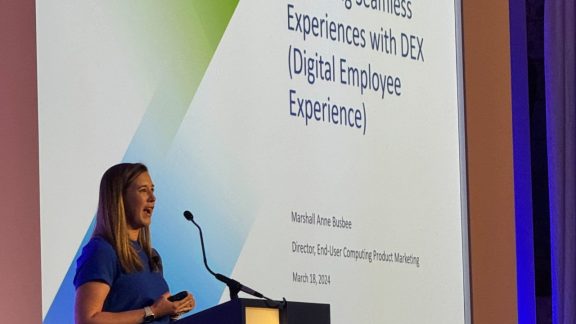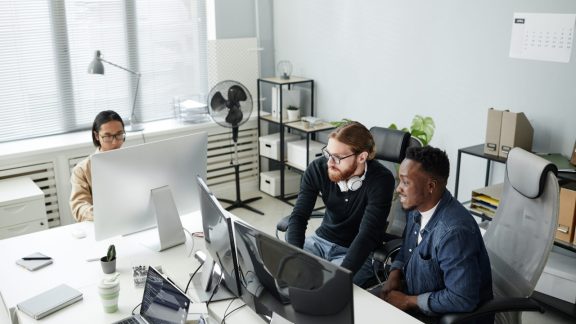
The past month has been incredibly busy for Sanjay Poonen and our VMware End-User Computing team. We announced updates to our digital workspace offerings (VMware Workspace ONE, AirWatch 8.4 and Identity Manager); expanded our partnership with IBM; added partnerships with key cloud security players to VMware’s Mobile Security Alliance; and launched a brand new security solution, VMware TrustPoint, powered by Tanium.
With all this going on, we somehow snagged 20 minutes with Sanjay, executive vice president and general manager, End-User Computing, VMware.
Here’s the Q&A of our candid conversation about how Sanjay’s very first digital experience changed his life, his favorite go-to apps and his unique vision for VMware’s future.
Did you miss the big news? Read All 6 HUGE VMware EUC Product Announcements Right Here
1. Sanjay, if you think back, what was your first time working digitally?
Sanjay: Most of my growing up was done in India in the ’80s. Many of the folks here in the U.S. had some access to computing resources at that time. I had none. But I really enjoyed math, so most of my work was on paper and pencil—far from digital. Then my dad happened to get one of these old, hand-me-down computers. I think it was Atari. It was an old one that we were able to get in India. I could play a few games, but I started programming. That changed my life fundamentally. Later, I was very fortunate to come to the U.S. with $50 in my pocket and a scholarship to study computer science at Dartmouth College. Dartmouth was one of the first colleges in the U.S. to embrace Apple Macintoshes in the dorms, combined with time-sharing and distributed computing.
Fast forward to today, and now I’m at VMware, and we’ve taken computing to a whole new level, bridging the mainframe era to the client-server era. And now, we have a very credible offering for the mobile-cloud era with our digital workspace solution.
2. You’re traveling constantly around the world, and you’re probably in different cities every month. What are the top three apps that you use most in your personal life, and the top three apps that you use to do your job?
Sanjay: In my personal life, I’m mobile-centric. I’ve got two phones. I’ve got an Android phone and an iPhone. I’ve got an iPad. I’ve got a Windows 10 laptop. I’ve got everything. When you look at my personal life, I use Gmail, Twitter, Facebook, banking and a few other consumer apps.
When it comes to work, much of the experience starts with our digital workspace app, Workspace ONE. I simply log in and have access to Boxer, Salesforce, Concur, Workday and a few other “micro” mobile apps our IT team has built, like vApprove and PeopleFinder.
[Related: Our Biggest End-User Computing News of 2016, Yet]
3. You’ve mentioned the “digital workspace” concept a few times. How did the digital workspace evolve, and how did we get to where we are today?
Sanjay: When you think about digital transformation, which is the common word that’s being used in the IT industry, you need to look at a couple things:
- How business models evolve to be more digital,
- How businesses take manual processes and make them more automated and
- How they take paper processes and make them more mobile-driven.
That’s digital transformation. And the digital workspace proposition that VMware can deliver is two-fold.
One, is we think we can modernize people’s infrastructure, which is really what VMware does well by taking cost out of the data center. That’s been a significant digital transformation to make it more software-defined. That movement of workloads between private and public clouds and on-prem infrastructure allows us to be the de facto company that can really drive that digital transformation for cloud infrastructure.
The second piece of it is the digital transformation in the workplace, and how people are changing the way in which they work. You have your desktop, your laptop, your tablet, your phone or your Tesla. Your apps come to you on any device. That aspect of digital workplace transformation is what we’ve been squarely focused on. We call that “working at the speed of life.” We decided to tailor our products toward delivering that vision of the digital workspace, and our offering is called Workspace ONE.
4: What does “consumer simple and enterprise secure” mean?
Sanjay: Take your best examples of consumer simple devices and apps. The best examples are the ones we use all the time: the music experience of iTunes, the social experience of Facebook, the movie experience of Netflix. There’s a tremendous amount of customer satisfaction, because these user experiences are simple and delightful.
Then you take some of the products that I use in the enterprise world that are secure, but the usability stinks. Most business software gets the enterprise security and the functionality piece really well. They just aren’t built with a design-seeking mindset, where you’re thinking about how the user belongs to it.
We’re trying to bring those worlds together by creating business apps that epitomize next-generation security in a pristine user experience. When consumer simplicity meets enterprise security, you get magic. That’s what we’re trying to deliver in the digital workspace.
5: What distinguishes VMware’s digital workspace vision from others in the market?
Sanjay: For one, nobody has a unified solution the way where we’re going after it.
There are VDI (virtual desktop infrastructure) players, there are EMM (enterprise mobility management) players and there’s identity players. Then, of course, there are thousands of mobile productivity apps providers. Nobody, even if they’re trying to do all three, is doing it the way that’s optimized for the various system platforms: iOS, Android and Windows. They don’t even know how to adjust to these platforms with their own software offering.
And as a “Switzerland” type player, we’re strategically aligned with Apple, Android/Google, Samsung and Microsoft for Windows 10. And when customers ask us how we’re using (our technology) internally, we can talk to them about the millions of dollars of productivity gains and ROI benefits we’ve experienced by drinking our own champagne.
6: Sanjay, you mentioned mobile productivity apps, and we recently acquired the mobile email app Boxer. Where do you see Boxer playing a role in the digital workspace, and how do you see Boxer being integrated into Workspace ONE?
Sanjay: Boxer is a beautiful user experience used by many in the consumer world. It’s a delightful user experience for email, calendar, contacts—what people call personal information apps. Now, by applying VMware’s consumer simple and enterprise secure vision, Boxer is a key component to the digital workspace.
We now have a much stronger productivity offering with a more delightful user experience than any competitor on the market, and Boxer is a very prominent part of it. In fact, when you buy Workspace One in the standard edition, which is the lowest offering in the boat, you get Boxer for free.
[Related: VMware Boxer: Consumer Simple, Enterprise Secure Mobile Productivity]
7: VMware deployed Workspace One to nearly all of our 20,000 employees, and you’ve been using it now for a number of months. What’s your favorite innovation or feature?
Sanjay: I think the simplicity of multitasking. I love the simplicity of the identity management and authentication process that now provides me access to the 400 applications that VMware uses, 150 of which are SaaS applications. No tokens, multi-factor authentication is easy. I’ve never had that type of experience with simple, single sign-on into Windows and third-party and internal applications—the technology’s there behind the scenes, bringing together our barrage of capabilities. It’s amazing.
A huge thanks to Sanjay for taking the time to share his thoughts with the VMware End-User Computing Blog Community! Share your questions in the comments below and on Twitter @VMwareHorizon and @AirWatch, and we’ll share Sanjay’s answers with you all. You can also read Sanjay’s story at VMware Radius.
Because you liked this blog:







